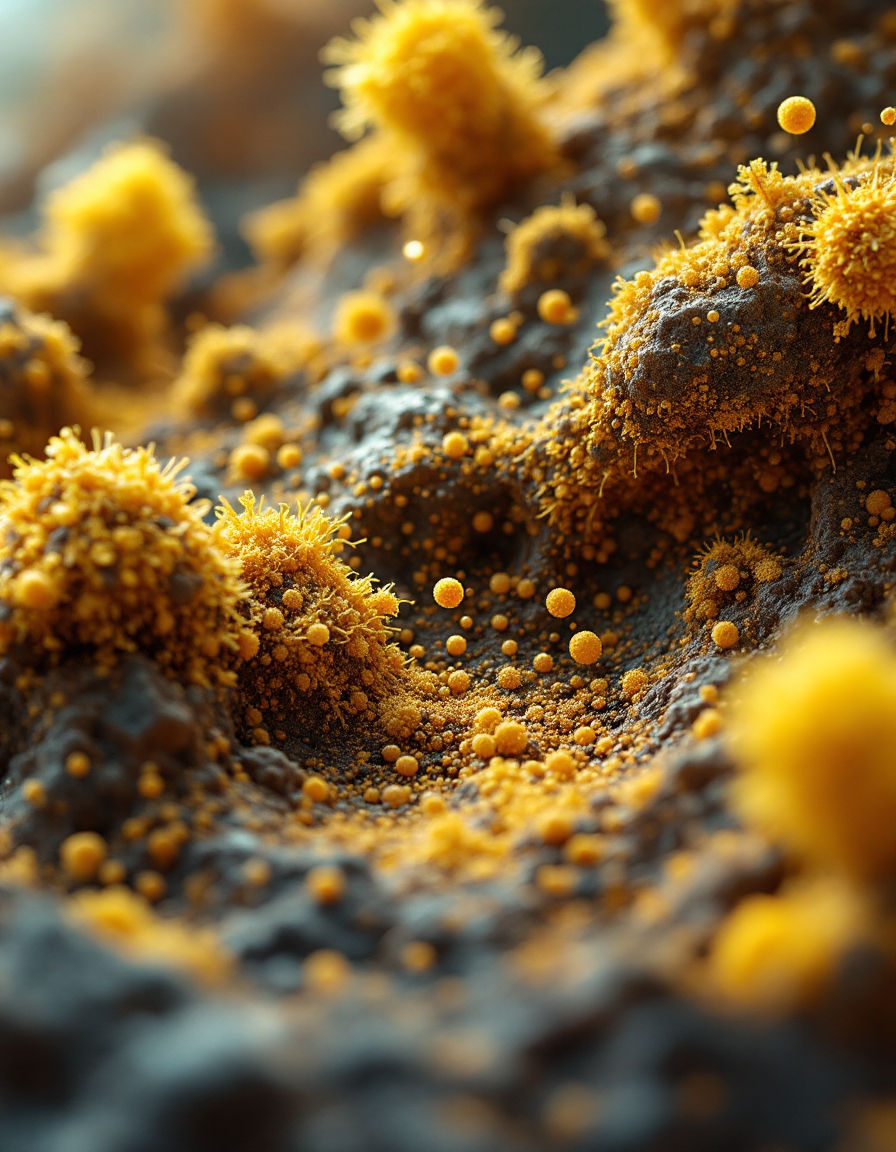How Thiobacillus, Sulfur, and Vermicompost Enhance Water-Soluble Phosphorus in Hard Rock Phosphate
- Pixel Kumar
- 5 days ago
- 5 min read

Phosphorus is an essential nutrient for plants, playing a crucial role in energy transfer, photosynthesis, and overall plant growth. In the world of agriculture, phosphorus is often supplied through fertilizers, with one of the most common sources being hard rock phosphate (HRP). However, HRP contains phosphorus in an insoluble form, meaning that plants cannot readily absorb it. To address this issue, various biological and chemical strategies are employed to enhance the availability of water-soluble phosphorus, making it accessible to plants. Among these strategies, the combined action of Thiobacillus bacteria, sulfur, and vermicompost has shown considerable potential in improving water-soluble phosphorus content in hard rock phosphate.
Understanding Hard Rock Phosphate (HRP) and Its Limitations
Hard rock phosphate is a naturally occurring mineral used as a phosphorus fertilizer. However, the phosphorus in HRP exists primarily in a form that is insoluble in water. For plants to absorb phosphorus, it must be in a water-soluble form, which is typically the orthophosphate ion (H₂PO₄⁻ or HPO₄²⁻). HRP’s insolubility means that it can be inefficient for plant growth unless transformed into a more accessible form. This is where the synergistic actions of Thiobacillus bacteria, sulfur, and vermicompost come into play.
1. Thiobacillus: The Sulfur-Oxidizing Bacteria
Thiobacillus is a genus of bacteria known for its sulfur-oxidizing capabilities. These bacteria are capable of converting elemental sulfur into sulfuric acid through a biochemical process known as oxidation. This process is highly significant in improving the solubility of minerals, including phosphate rock.
Here’s how Thiobacillus helps:
Acidification of the Soil: The sulfuric acid produced by Thiobacillus helps acidify the soil. This acidification lowers the pH of the soil, which increases the solubility of phosphorus compounds in HRP, making them more accessible to plants. The presence of sulfuric acid enhances the dissolution of calcium phosphate and other insoluble phosphate minerals, releasing water-soluble phosphate.
Enhanced Phosphate Availability: The sulfuric acid also reacts with the calcium ions in HRP to form calcium sulfate (gypsum), which is a more water-soluble compound. The phosphorus is then released in a soluble form that plants can absorb, increasing their ability to uptake phosphorus for growth.
2. Sulfur: A Vital Component for Phosphorus Solubilization
Sulfur is a key element in the process of enhancing phosphorus availability. In addition to being a vital nutrient for plants, sulfur directly influences the solubility of phosphorus in HRP. Sulfur is often applied in its elemental form, which is then oxidized by bacteria such as Thiobacillus into sulfuric acid.
The role of sulfur in improving phosphorus availability includes:
Releasing Phosphorus: When sulfur is oxidized to sulfuric acid, it reacts with calcium phosphates (the main form of phosphorus in HRP) to release soluble phosphorus. This reaction lowers the pH of the soil, making phosphate ions more available to plants.
Improved Fertilizer Efficiency: The addition of sulfur, especially in the presence of sulfur-oxidizing bacteria like Thiobacillus, can make hard rock phosphate a more efficient source of phosphorus. This method reduces the need for synthetic fertilizers and can lead to more sustainable agricultural practices.
3. Vermicompost: A Natural Source of Nutrients and Microorganisms
Vermicompost, produced by the decomposition of organic matter by earthworms, is a rich source of nutrients and beneficial microorganisms. It has been widely used to enhance soil health and fertility. When it comes to improving the availability of water-soluble phosphorus in HRP, vermicompost offers several advantages:
Microbial Activity: Vermicompost contains a variety of beneficial microbes, including phosphorus-solubilizing bacteria. These microorganisms help break down organic matter and mineralize nutrients, including phosphorus, making them more available to plants.
Enhanced Soil Structure: The organic matter in vermicompost improves soil structure, water retention, and aeration. This creates a better environment for root growth, which can lead to more efficient phosphorus uptake by plants.
Complementing Other Amendments: When combined with sulfur and Thiobacillus, vermicompost enhances the effects of these substances on phosphorus availability. The organic matter in vermicompost provides a habitat for sulfur-oxidizing bacteria, while the phosphorus-solubilizing microbes in the vermicompost work in concert with Thiobacillus to release more phosphorus from HRP.
The Synergy Between Thiobacillus, Sulfur, and Vermicompost
The combination of Thiobacillus, sulfur, and vermicompost creates a powerful synergy that enhances the solubility of phosphorus in hard rock phosphate. Here's how these components work together:
Sulfur and Thiobacillus work hand-in-hand to acidify the soil and release soluble phosphorus from HRP.
Vermicompost provides a source of organic matter and beneficial microorganisms that further support phosphorus mineralization and increase microbial activity in the soil.
The combined effect of the three not only improves phosphorus availability but also enhances overall soil health, making it a sustainable and efficient approach to phosphorus management.
The use of Thiobacillus, sulfur, and vermicompost to enhance the availability of water-soluble phosphorus in hard rock phosphate is a promising and sustainable method for improving soil fertility and plant growth. This combined approach helps to break down the insoluble phosphorus found in HRP, making it accessible to plants while simultaneously improving soil health and microbial activity. By leveraging the natural processes of sulfur oxidation, bacterial activity, and organic matter decomposition, farmers can optimize phosphorus use, reduce the reliance on synthetic fertilizers, and contribute to more sustainable agricultural practices.
Frequently Asked Questions
1. What is Hard Rock Phosphate (HRP)?
Hard Rock Phosphate (HRP) is a naturally occurring mineral that is used as a source of phosphorus for plants. However, the phosphorus in HRP is not readily available for plant uptake because it is in an insoluble form. For plants to absorb phosphorus, it needs to be in a water-soluble form.
2. Why is phosphorus important for plants?
Phosphorus is essential for plant growth and development. It is involved in key processes like energy transfer, photosynthesis, and the formation of nucleic acids and cell membranes. Without enough phosphorus, plants may exhibit stunted growth, poor root development, and reduced yields.
3. How does Thiobacillus improve phosphorus availability in HRP?
Thiobacillus is a type of sulfur-oxidizing bacteria that produces sulfuric acid as part of its metabolic process. This acidification of the soil helps dissolve the insoluble phosphorus in HRP, converting it into a more water-soluble form that plants can absorb.
4. How does sulfur contribute to phosphorus solubilization?
Sulfur, when added to the soil, is oxidized into sulfuric acid, which lowers the pH of the soil. This acidic environment increases the solubility of calcium phosphate (a form of phosphorus in HRP), making phosphorus more available to plants. Sulfur also complements the work of Thiobacillus bacteria, enhancing the overall phosphorus release from HRP.
5. What role does vermicompost play in improving phosphorus availability?
Vermicompost is rich in organic matter and contains beneficial microorganisms, including those that solubilize phosphorus. The microorganisms in vermicompost help break down organic matter, releasing phosphorus into a form that plants can utilize. Additionally, vermicompost improves soil structure, allowing better root growth and enhancing nutrient uptake.
6. How does the combination of Thiobacillus, sulfur, and vermicompost improve phosphorus availability?
The combination of these three elements works synergistically to improve the solubility of phosphorus in HRP:
Thiobacillus and sulfur work together to acidify the soil, promoting the release of soluble phosphorus.
Vermicompost provides organic matter and beneficial microbes that further aid in phosphorus mineralization.
The combined effect enhances overall soil health, microbial activity, and phosphorus availability, leading to better plant growth.



Comments